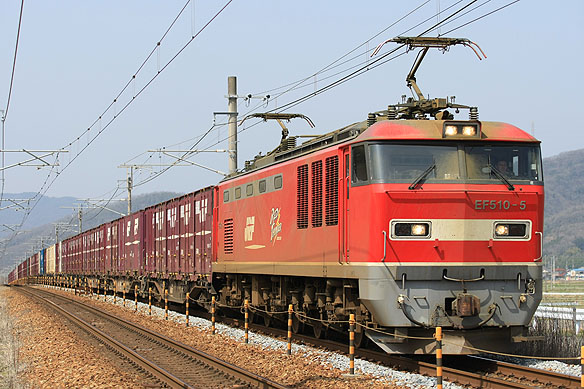Background and overview
Class EF81 multi-voltage AC/DC electric locomotive used on freight services of the Sea of Japan coastal route consisting of Ou, Uetsu, Shinetsu, Hokuriku, and Kosei lines electrified at the mixture of 1500V DC, 20kV 50Hz AC, and 20kV 60Hz AC was getting superannuated. Because of this, JR Freight developed the pre-production type of the next generation multi-voltage AC/DC electric locomotive, class EF510-0, having a Bo-Bo-Bo wheel arrangement and 100.8 tons mass in 2002.
Car body
Its body features double ended boxcab style constructed by steel. Their
body skin features weatherproof high-tension steel sheet for anti-corrosion
improvement. The both ends are no gangwayed, feature dogleg streamline
shape, and have two rectangle shaped headlights above its windscreens and
a pair of rectangle shaped headlights and tail lights in left and right
below its windscreens. The disconnecting switch, circuit breaker, and main
fuse are fitted inside their body in order to protect them against salt
damage and heavy snow. So, only two single arm current pickups, FPS5, and
a protection switch are fitted on its roof. An aisle is fitted on one side
of the machine room located at the centre of the body and switched to the
opposite side at middle of the body to realize easy maintenance and easy
access to the cab. For these reasons, skylight windows are fitted on the
left-side and louver windows on the right-side facing body side. Three
traction systems and an ancillary power supply are fitted at the centre
of the machine room, an electric blower to cool traction systems toward
the front, a traction transformer and an AC/DC changer toward the rear,
and each electric blower to cool a traction resistor unit for rheostatic
brake at the both end of the machine room. Airtightness of the cabs are
reinforced and an air conditioner is also fitted to cool the cab. Their
body is painted in red with ivory and gray narrow skirtings.
Bogies
Bogies are FD7N for outer and FD8A for centre. Their bogies feature bolster-less
secondary air suspension, axle arm type journal box supporting system,
and the Watts linkage draw gear with low centre pivot. These bogies adopt
the yaw dampers to ensure smooth ride characteristics even at 110km/h.
An air suspension cover is fitted for antifreezing. Their brake rigging
is single tread brake device having brake shoe made of sintered alloy.
FD8A also employs parking brake device. Their drive unit features single
reduction axle-hung. A roller bearing is employed for motor suspension
bearing of the nose suspended motor in order to improve meshing precision,
provide maintenance free, and prevent galling. The gear ratio is 5.125.
Traction unit and ancillary equipments
They are equipped with 3 traction systems, FMPU16, which consist of a pair of a 3-level converter employing Insulated Bipolar Transistor (IGBT) and a 2-level Variable-frequency drive (VFD) employing IGBT and control 6 AC induction motors, FMT4, with power output of 565kW on axle basis featuring improved power factor, higher harmonic wave reduction, and fields-oriented control to realize quick response of traction motor torque control while wheel slip. Their ancillary power unit is FAPU6 which consists of a rectifier powered from tertiary winding of the traction transformer and an inverter featuring Pulse Width Modulation (PWM), and supplies 3-phase 440VAC. In addition, for single-phase 100VAC and 100VDC loads, it supplies step-down three-phase 440VAC or step-down and rectified three-phase 440VAC. In case of the auxiliary power supply unit failure, one VFD unit for No.1 traction motor can switch to supply electricity as the backup auxiliary power supply unit to achieve higher redundancy. Their traction transformer featuring shell and forced oil cooling is FTM4 with a power output of 3,490kVA. They are also equipped with two motor driven air compressors, FTC2000-FMH3105 between bogies and two single air current pickups, FPS5, applying spring lift, pneumatic drop, and pneumatic unlock mechanism corresponding to AC electrification on their roof. Its independent brake which makes brake applications on the head-of-train locomotive employs the electric commanding brake with the rheostatic brake. On the other hand, Automatic brake which provides service and emergency braking control for the entire train is controlled by the pressure reduction of the brake pipe depending on the notch command signal. Dynamic braking is enabled over 30km/h. If the regenerative brake is not sufficient, additional brake is provided by pneumatic friction brake. Because of this, they are equipped with a traction power resistor unit rated for sufficient value for hauling 1300-tonne at 10‰ grade.
Additional delivery
JR delivered 22 full production vehicles featuring narrower ivory band and "Red Thunder" bodyside branding over the period from 2003 until 2013.
Extensive test and revenue services
The pre-production vehicle, EF510-1, underwent extensive testing to confirm that EF510-1 had a designed performance, then entered revenue services for endurance running test over the period from February 2002 until October. After that they were delivered to displace EF81 multi-voltage AC/DC electric locomotives used on freight services of the Sea of Japan coastal route. At first, they were used on freight services between Osaka freight terminal and Niigata freight terminal. However, their services were extended to Aomori signal station in 2007, and to Kudara freight terminal in 2012. Furthermore, their services were extended to Okayama freight terminal and Nagoya freight terminal in 2015, and Obu, Mino-Akasaka, and Tajimi stations in Aichi prefecture in 2022. |
|
| Technical Data |
| Items |
Data |
| Supply
Voltage |
1,500VDC,
20,000V 50/60Hz AC |
| Service
speed |
110km/h |
| Max power |
3,390kW |
| Length |
19,800mm |
| Width |
2,887mm |
| Total
mass |
100.8t |
| Axles location |
B0-B0-B0 |
| Bogie |
FD7N (End), FD8A (Intermediate) |
| Current
collector |
FPS5 |
| Traction
motor |
FMT4~6 |
| Drive (Gear ratio) |
nose suspended drive (5.125) |
| Traction system |
FMPU16 |
| Designed
by |
JR Freight |
|
|





